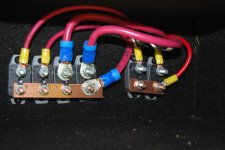Recovered from 25-May-2010
Recovered
OK, I did that. The voltage on the dc output on the converter is 13.68 when camper is plugged into shore. I unplugged from shore with just one battery hooked up and still no power in camper at all. What am i missing? There are 2 wires (1 big red cable and 1 smaller red cable) connected to the common side of the battery disconnect switch. The bigger red cable is the cable on the bottom of the 4 block in picture attached. The smaller red cable is connected to the bottom of the 2 block in the picture. One of the cables on top of 4 block goes to fuss box and then another red cable is connected beside that one and goes to back of converter. HELP!

